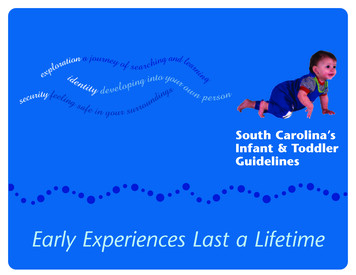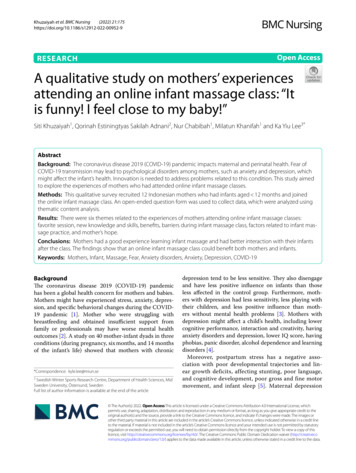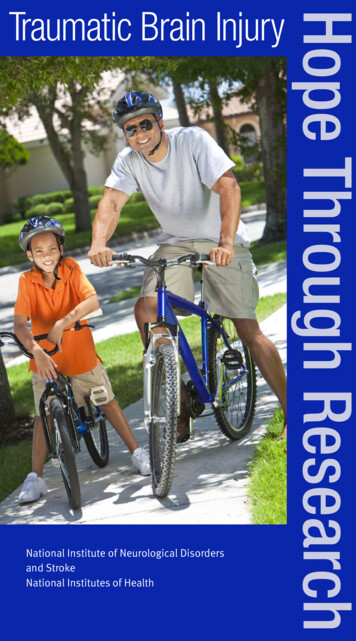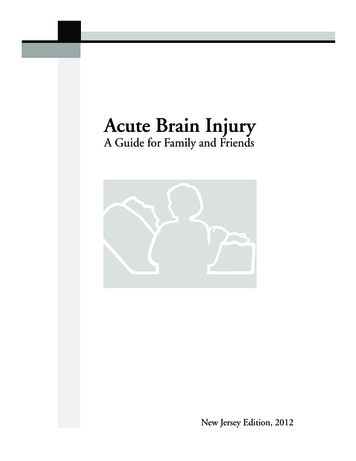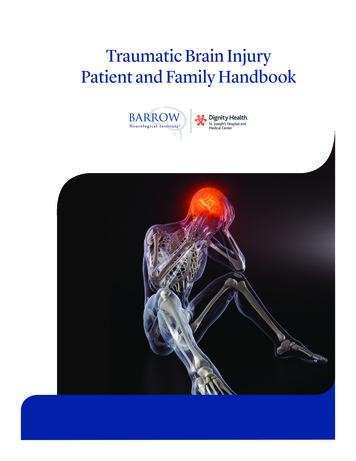
Transcription
Infant Brain Atlases from Neonates to 1- and 2-Year-OldsFeng Shi1, Pew-Thian Yap1, Guorong Wu1, Hongjun Jia1, John H. Gilmore2, Weili Lin3, Dinggang Shen1*1 IDEA Lab, University of North Carolina at Chapel Hill, Chapel Hill, North Carolina, United States of America, 2 Department of Psychiatry, University of North Carolina atChapel Hill, Chapel Hill, North Carolina, United States of America, 3 MRI Lab, Department of Radiology and BRIC, University of North Carolina at Chapel Hill, Chapel Hill,North Carolina, United States of AmericaAbstractBackground: Studies for infants are usually hindered by the insufficient image contrast, especially for neonates. Priorknowledge, in the form of atlas, can provide additional guidance for the data processing such as spatial normalization, labelpropagation, and tissue segmentation. Although it is highly desired, there is currently no such infant atlas which caters forall these applications. The reason may be largely due to the dramatic early brain development, image processing difficulties,and the need of a large sample size.Methodology: To this end, after several years of subject recruitment and data acquisition, we have collected a uniquelongitudinal dataset, involving 95 normal infants (56 males and 39 females) with MRI scanned at 3 ages, i.e., neonate, 1-yearold, and 2-year-old. State-of-the-art MR image segmentation and registration techniques were employed, to constructwhich include the templates (grayscale average images), tissue probability maps (TPMs), and brain parcellation maps (i.e.,meaningful anatomical regions of interest) for each age group. In addition, the longitudinal correspondences between agespecific atlases were also obtained. Experiments of typical infant applications validated that the proposed atlasoutperformed other atlases and is hence very useful for infant-related studies.Conclusions: We expect that the proposed infant 0–1–2 brain atlases would be significantly conducive to structural andfunctional studies of the infant brains. These atlases are publicly available in our website, tion: Shi F, Yap P-T, Wu G, Jia H, Gilmore JH, et al. (2011) Infant Brain Atlases from Neonates to 1- and 2-Year-Olds. PLoS ONE 6(4): e18746. doi:10.1371/journal.pone.0018746Editor: Hitoshi Okazawa, Tokyo Medical and Dental University, JapanReceived December 14, 2010; Accepted March 10, 2011; Published April 14, 2011Copyright: ß 2011 Shi et al. This is an open-access article distributed under the terms of the Creative Commons Attribution License, which permits unrestricteduse, distribution, and reproduction in any medium, provided the original author and source are credited.Funding: This work was supported in part by NIH grants EB006733, EB008760,EB008374, EB009634, MH088520, MH070890, MH064065, NS055754, andHD053000. The funders had no role in study design, data collection and analysis, decision to publish, or preparation of the manuscript.Competing Interests: The authors have declared that no competing interests exist.* E-mail: dgshen@med.unc.educaters for a broader range of human brains, and can thus causeproblem when used to propagate on-atlas information to any othersubject due to confounding anatomical variability [7]. In responseto this, population-based atlases were introduced, e.g., theMNI305 [8] and ICBM152 brain atlases [9], which were obtainedby averaging the anatomical magnetic resonance (MR) images of305 and 152 adult brain images, respectively. Besides normalbrain atlases, disease-specific atlases as well as genetic atlases ofhumans were also widely studied [10,11,12,13,14,15,16].Although numerous human brain atlases have been produced,they are mostly developed for adults. Infant atlases, however, arenot well developed. Recent studies suggested that using adult oreven pediatric atlases may compromise accuracy in analyzinginfant brain images [11]. The degraded performance stems fromthe fact that dynamic and significant growth processes occur in thefirst years of life; thus, an atlas not created for infants simply fails toreflect their anatomy. Three major difficulties associated withchanges due to development, MR imaging inconsistency, andcohort size confound the efforts of constructing infant atlases. First,fast development of the infant brain demands dedicated infantatlases constructed for specific age group (i.e., time-point), e.g.,neonates, 1-year-olds, and 2-year-olds. As reported in [17], MRimaging indicates that the neonatal brain is only half the volume ofadult brain, and grows to about 90% adult brain volume at theIntroductionAn atlas usually refers to a map with spatial recording ofrelevant information. Brain atlases, embedding knowledge ofstructural and functional properties of neuroanatomical sites, arewidely used in computational neuroanatomy for pedagogicalpurposes, surgical planning, disease diagnosis, and medical imageanalysis [1,2,3]. An atlas, in its different forms, can be used as areference for normalization of a group of individuals, a probabilitymap for defining tissue prior distribution, or a spatial map forbrain parcellation. Brain atlases were initially collections ofdetailed drawings of brain structures by anatomists according tothe autopsy of individual subjects (see [4] for review). These paperatlases have facilitated a great measure of success in understandingthe underlying anatomy of human brains. With the advancementof computing and medical imaging technologies, digital brainatlases constructed for different imaging modalities are increasingly more common and provide more precise delineation of brainstructures and allow automatic processing of large datasets withminimal human intervention.Many existing brain atlases are based on a single subject or alimited number of individuals, e.g., the Brodmann atlas [5] andthe Talairach & Tournoux atlas [6]. Atlases as such cannotguarantee capturing of subject-independent information whichPLoS ONE www.plosone.org1April 2011 Volume 6 Issue 4 e18746
Infant 0-1-2 Brain Atlasesclustering and Gaussian blurring [20]. Gilmore et al. proposed aneonatal brain parcellation map, where 16 cortical regions, 20subcortical regions, brainstem, and cerebellum were defined byanatomical experts [18]. Studies dedicated to infant atlasconstruction and their atlases currently publicly available werelisted in the lower panel of Table 1 [11,12,26,27]. Kazemi et al.provided an infant template [11]. Kuklisova-Murgasova et al.presented a 4D atlas particularly for premature neonates, by using142 subjects with average gestation age of 29.462.7 weeks at birth[26]. A 1-year-old atlas was constructed in [12], with template andTPMs available. Gousias et al. non-rigidly warped 30 manualparcellation maps of 30 normal adult brains (each containing 83anatomical regions) onto each of 33 2-year-old subjects, then fusedthe 30 warped label maps into a final map for each 2-year-oldsubject [27]. As clearly indicated in Table 1, few atlases targetingnormal newborns are publicly available, and they generally havelimited features to meet various image processing needs.Specifically, in the context of the three main atlas applications ininfant studies – spatial normalization using templates, guidingtissue segmentation using TPMs, and structural labeling using ananatomical parcellation map, we observed form the atlasesprovided in the above studies that: (1) there are no availableTPMs that can be used for guiding tissue segmentation of normalneonatal subjects; (2) also missing are the neonatal anatomicalparcellation maps, which are very important for automateddelineation of regions of interest (ROIs) in fMRI or DTI studies;(3) if atlases are jointly used in the studies involving different agegroups, such as combing the neonate [11], 1-year-old [12], and 2year-old atlases [27], the consistency in the obtained results maybe questionable, because atlases were constructed from differentsubjects and groups using different segmentation and registrationmethods.In this paper, we aim to construct a set of dedicated infantatlases for neonates, 1-year-olds, and 2-year-olds, referred to asinfant 0–1–2 atlases. First, a total number of 95 subjects withcomplete 0–1–2 longitudinal scans were collected. Second, weapply state-of-the-art infant longitudinal segmentation [28] andgroupwise registration techniques [29] for constructing the brainatlases. Third, an atlas is constructed for each of the three agegroups, together with the relevant longitudinal correspondences.Our approach is detailed in the Method section. We then describeexperiments to evaluate the performance of the proposed atlases intypical infant studies related applications. The Discussion sectionhighlights the novelty of the proposed method and some possiblefuture research directions. Finally, the Conclusion sectionconcludes the paper.end of the second year. Similarly, the white matter (WM)myelination process is also associated with early brain development. Most WM is unmyelinated in neonates. Myelinationprogresses in the brain from central to peripheral, from inferiorto superior, and from posterior to anterior. This process continuesin the 1-year-old brain with adult-like pattern occurring in the 2year-old brain [18]. Due to this dynamic change in the first yearsof life, atlases representing neonates, 1-year-olds, and 2-year-oldsshould characterize specific anatomical patterns. Therefore, atlasesconstructed for each of the three infant stages are highly desired.By doing so, more age-related anatomical characteristics can bepreserved in each stage. Second, many studies are obstructed by thequality insufficiency of infant MR images, which is even moresevere in the case of neonatal images [19,20]. Specifically, due tothe small brain size and developing tissue properties, the quality ofinfant images is typically poor with insufficient spatial resolution,low tissue contrast, and ambiguous tissue intensity distribution,which confound subsequent operations such as tissue segmentationand image registration. Dedicated infant segmentation methodsneed to be employed to handle image quality problems and toprovide reliable results for ensuring the success of subsequentoperations. Third, a large sample size is desired for constructingatlases. However, obtaining infant MRI data can be difficult [11].Acquisition of images of infants requires additional effort inensuring that the infant remains still throughout scanning –something which can be achieved easily by adults, but much lesseasily by infants. Moreover, the availability of longitudinal followups is also highly dependent on the cooperation of the infants andtheir parents. All these factors hinder the collection of a substantialnumber of images that are required for building a reliable atlas.Based on the typical applications, an atlas should comprise thefollowing major components (see Fig. 1): (1) a template (i.e.,grayscale average image), which serves as the registration referencefor spatial normalization of a population of images; (2) a set oftissue probability maps (TPMs) of gray matter (GM), white matter(WM) and cerebrospinal fluid (CSF) for guiding segmentation; (3)an anatomical parcellation map for structural labeling. An atlas assuch is highly desired for infant related studies.In the upper panelof Table 1, we list a number of recently published infant studies, inwhich template, TPMs, and anatomical parcellation map wereconstructed to facilitate their subsequent segmentation orstructural labeling process [18,19,20,21,22,23,24,25]. In moststudies, the components of atlases were obtained by directlyaveraging a number of presegmented and aligned infant images.Some others, like Xue et al., simulated the TPMs by using theinitial segmentation of the to-be-segmented image by k-meansMaterials and Methods2.1 Subjects and MRI AcquisitionSubjects used in this paper were part of a large study of earlybrain development in normal children [18]. The experimentalprotocols were approved by the institutional review board of theUniversity of North Carolina (UNC) School of Medicine. Theparents were recruited during the second trimester of pregnancyfrom the UNC hospitals and written informed consent forms wereobtained from all the parents. The presence of abnormalities onfetal ultrasound, or major medical or psychotic illness in themother, was taken as exclusion criteria. The infants were free ofcongenital anomalies, metabolic disease, and focal lesions. None ofthe subjects was sedated for MRI. Before the subjects wereimaged, they were fed, swaddled, and fitted with ear protection.Images were acquired on a Siemens head-only 3T scanner(Allegra, Siemens Medical System, Erlangen, Germany) with aFigure 1. A sample atlas and its oS ONE www.plosone.org2April 2011 Volume 6 Issue 4 e18746
Infant 0-1-2 Brain AtlasesTable 1. Summary of recently published atlas-related infant brain studies.NMR FieldStrengthAge at tionMapPublic AvailabilityStudies that constructed templates, TPMs, and parcellation mapsPrastawa et al., 20053Neonate3TYesYes--Weisenfeld et al., 2006a13Neonate (GA 42 weeks)1.5TYesYes--Weisenfeld et al., 2006b20Neonate (GA 42 weeks)1.5TYesYes--Xue et al., 200725Neonate (GA 35 weeks)3TYesYes--Song et al., 20079Neonate (PA,10 days)-YesYes--Gilmore et al., 2007-Neonate---38 ROIs-Weisenfeld et al., 200915Neonate (GA 40 weeks)1.5TYesYes--Shi et al., 2010b68Neonate (GA 41 weeks)3TYesYesStudies that established infant atlases for public useKazemi et al., 20077Neonate (GA 39-42 weeks)1.5T and va-Murgasovaet al., 2010142Premature neonate(GA 29-48 weeks)3TYesYes-www.brain-development.orgAltaye et al., tware/infant.phpGousias et al., 2008332-year-old1TYes-83 Note: ‘‘Yes’’ means the item was generated in the study. ‘‘-‘‘ means not available. GA means gestational age. PA means postnatal age. ROI means region of ular polarized head coil. For T1-weighted images, 160 sagittalslices were obtained by using the three-dimensional magnetization-prepared rapid gradient echo (MPRAGE) sequence:TR 1900 ms, TE 4.38 ms, inversion time 1100 ms, FlipAngle 7u, and resolution 16161 mm3. For T2-weightedimages, 70 transverse slices were acquired with turbo spin-echo(TSE) sequences: TR 7380 ms, TE 119 ms, Flip Angle 150u,and resolution 1.2561.2561.95 mm3. Data were collectedlongitudinally at 3 age groups: neonates, 1-year-olds, and 2-yearolds. Data with motion artifacts was discarded and a rescan wasmade when possible. Finally, complete 0–1–2 data of 95 normalinfants was acquired. The demographic information was summarized in Table 2. Gestational ages were between 38.7 and 46.4weeks at the first dates of examination. The variation of age atMRI for each scan is relatively small and the population can bedivided in age groups concentrated around 0, 1, and 2 years ofage.2.2 Image preprocessingBefore further operation, all images were preprocessed using astandard procedure. Non-brain tissues such as skull and dura werestripped with Brain Surface Extractor (BSE) [30], followed bymanual editing with ITK-SNAP software [31] to ensure accurateskull removal. Bias correction was performed on all images withnonparametric nonuniform intensity normalization (N3) method[32] to reduce the impact of intensity inhomogeneity and thusimprove the performance of the subsequent tissue segmentation.T2-weighted images were resampled to have a resolution of16161 mm3. Note that one image modality with better tissuecontrast was selected for each age group for delineation ofanatomical patterns: T2 for neonates, and T1 for 1- and 2-yearolds [28].2.3 Data process and atlas constructionTo build the infant 0–1–2 atlases, the images need to besegmented, registered to a common space, and averaged togenerate the atlases, representing subject-independent populationinformation. The key to atlas construction involves performingaccurate tissue segmentation to identify tissue structures androbust registration to determine the anatomical correspondencesacross age groups and subjects. Specifically, we perform threesteps, i.e., longitudinal tissue segmentation, anatomical labeling,and unbiased groupwise atlas construction, for constructing theatlases as illustrated in Fig. 2.2.3.1 Step 1: Longitudinal Tissue Segmentation. To buildan atlas, a given population of brain images needs to besegmented. The quality of the final atlas is directly related to thesegmentation accuracy. However, manual segmentation is tedious,time-consuming, and may lack reproducibility. As suggested inmany studies [12,19,24,28], automated segmentation of neonatalbrain images remains a challenging problem due to poor imagequality (low spatial resolution and tissue contrast) and high within-Table 2. Demographic information of the normal infantsused in this study.ScanNGenderAge at Birth(weeks)Age at MRI(weeks)First9556 males/39females37.961.8 ��163.4)2-year-oldGroupNote: GA means gestational age.doi:10.1371/journal.pone.0018746.t002PLoS ONE www.plosone.org3April 2011 Volume 6 Issue 4 e18746
Infant 0-1-2 Brain AtlasesFigure 2. The infant 0–1–2 atlas construction framework. From left to right, three main steps are involved in constructing the atlases:longitudinal tissue segmentation (step 1), anatomical labeling (step 2), and unbiased groupwise atlas construction (step 3). Note that the crosssectional and longitudinal registrations in the three steps were performed on the segmented images, since the intensity profile would changedramatically due to the myelination and 3.2 Step 2: Anatomical Labeling. An anatomicalparcellation divides the brain into multiple non-overlappingvolumes of interest (VOIs). Usually, the parcellation map of asingle-subject atlas is obtained by manual delineation, such as theBrodmann map which is based on cortical cytoarchitectonicorganisation of neurons [5]. Alternatively, the AutomatedAnatomical Labeling (AAL) map is based on anatomicallocalization such as gyrus and sulcus [35]. There are generallytwo ways to automatically generate a parcellation map for a groupof subjects: (1) Direct warping way, which directly warp an existingatlas to the mean image of the population for obtainingparcellation; (2) Indirect fusion way, which warps an existingatlas to each subject of the population and then fuses the warpedmultiple parcellation maps into a final result. A fusion-basedapproach as such has been proven to be more efficient than thedirect warping approach, and could result in a better-qualityparcellation map [13,36]. In this paper, we use the indirect fusionapproach to propagate the AAL map to our infant subjects.The AAL map was originally defined on the MontrealNeurological Institute (MNI) single subject brain MR image[35]. This brain image, Colin27, was created by averaging 27registered scans of a single subject, Colin Holmes [37]. 45anatomical VOIs in each hemisphere were defined based onanatomical characteristics, i.e., using main sulci as landmarks. Toreliably determine anatomical correspondence between theColin27 brain and the infants, we propose to use the 2-year-oldimage of the same subject as intermediate image for guiding theregistration. Specifically, we first warp the Colin27 brain to each2-year-old image in the population, and then propagate thewarped parcellation map longitudinally to its corresponding earlytime image. By using the 2-year-old image as a bridge image, wecan avoid the direct registration of adult AAL brain with neonatalbrain image (0-year-old image) and thus significantly reduce thepossible registration error. Note that the strategy of using theintermediate images as bridge for guiding registration has beenrecently employed as an effective technique in various groupwiseregistration methods, in which a registration pathway containingmultiple images as intermediate bridges is determined forprogressively registering one image to another image [38,39]. Byusing this approach, the parcellation maps of all subjects in eachtissue intensity variability. However, it is generally agreed thatsegmentation of 2-year-old images is relatively easy since they arebeginning to exhibit early-adult-like structural patterns [28]. It isalso noticed that major brain structures remain similar duringpostnatal development [33]. For instance, the major corticalgyrification has developed sufficiently during gestation in the thirdtrimester, and the cortical convolution patterns remain similareven after normal birth. For these reasons, in our previous work,we have used the warped TPMs of 2-year-olds as subject-specifictissue probabilistic priors for guiding segmentation of theirrespective neonatal images [28]. Compared with priors gatheredfrom images of different individuals, the subject-specific priorexhibits smaller anatomical variability with the to-be-segmentedimage, and thus provides more accurate and longitudinallyconsistent segmentation results.Specifically, as shown in Step 1 of Fig. 2, the 2-year-old images werefirst segmented by an adaptive fuzzy c-means (AFCM) algorithm [34].The resulting GM, WM and CSF TPMs were then used as subjectspecific priors for guiding segmentation of the 1-year-old and neonatalimages. A joint registration-segmentation approach [28] was adopted:(1) a registration step for aligning the 2-year-old image onto the earlytime-point image based on their segmented images (Note that theinitial registration was based on intensity images), and (2) asegmentation step for refining the segmentation result of the earlytime-point image based on the aligned TPMs. Segmentation isimplemented utilizing TPMs in conjunction with the subject’sintensity model. These two steps are iterated to refine the anatomicalcorrespondences between the 2-year-old image and the neonatal/1year-old image, and to improve the segmentation accuracy of theneonatal/1-year-old image. The final outcome is the segmentationresults at all three age groups, as well as the longitudinal deformationfields relating all images. In particular, in the segmentation step,multiple Gaussians are employed to model the intensity distribution ofeach brain tissue. For example, although myelinated and unmyelinated WM have very different intensity profiles, they can be jointlymodeled by multiple Gaussians with help of tissue priors obtainedfrom 2-year-old image. The final segmentation results of all imageswere visually inspected by a trained rater, to verify the segmentationquality and remove possible artifacts or errors generated by theautomated segmentation algorithm.PLoS ONE www.plosone.org4April 2011 Volume 6 Issue 4 e18746
Infant 0-1-2 Brain Atlasesthe deformations Dsi?j and Dsi?atlas(i) , i,j [ ½0,1,2 }, we could getthe longitudinal deformations/correspondences for each subject sin the common spaces of 3 ages. We then further averaged theselongitudinal deformations/correspondences from all 95 subjects,to obtain the final averaged longitudinal correspondences thatconnected the atlases of these 3 ages.group were obtained and then fused to generate the finalparcellation map by voxel-wise majority voting for the particulargroup. The resulting infant AAL map would facilitate infantstudies, such as region of interest (ROI) localization in fMRIstudies and volume changes of specific anatomical regions.Specifically, as shown in Step 2 of Fig. 2, the anatomicalcorrespondences between Colin27 brain to the early-adult-like 2year-old images were estimated by a hierarchical nonlineardeformable registration algorithm, namely HAMMER [40,41],based on their segmented images. Subvoxel registration accuracy(i.e., average 0.63 mm) could be achieved [41]. The resultingdeformation fields were then employed to warp the AAL map toeach of the 2-year-old images. The warped parcellation maps werethen propagated to the neonatal or 1-year-old image of the samesubject, with the longitudinal deformation fields obtained in Step1. Finally, we obtain a set of images, including intensity images,TPMs, and anatomical parcellation maps for each subject at eachage group.2.3.3 Step 3: Unbiased Groupwise Atlas Construction. Togenerate an atlas from a population, one subject is usually selectedas a reference template, to which all images are registered. Thisexplicit template selection may bias the subsequent data analysis,and can be avoided by recent advancement in registrationtechniques such as groupwise registration [29,42,43]. Therefore,we employ a recently developed feature-based groupwiseregistration algorithm [29] to align the subjects in each age groupto their age-specific common space.As shown in Step 3 of Fig. 2, for each age group, the individualimages of the 95 subjects were simultaneously registered to thecommon space. Briefly, all images were first roughly alignedtogether by using affine transformation. Then nonlinear groupwiseregistration [29] was employed. For each voxel, image featuresconsisting of image intensity, edge type, and geometric momentinvariants on three tissue types (WM, GM, and CSF) were firstcomputed. Then only the driving voxels, i.e., the anatomicallydistinctive voxels (e.g., in gyral crowns and sulcal roots) wereallowed to participate in identifying the correspondences. Thewarping of other non-driving voxels was guided by thedeformation given by these driving voxels. Specifically, for eachdriving voxel, we searched in the neighborhood of the subjectimage for a number of candidate matching points based on featuresimilarity. The driving voxel under consideration was then movedto the mean location of all candidate points. Thin-plate splineswere adopted to interpolate the sparse correspondences to obtain adense transformation field for warping each subject to thecommon space. By repeating these steps, i.e., correspondencedetection and dense deformation estimation, we are able tosimultaneously register all subject to the hidden common spaceand also the mean image.After groupwise registration, the atlases and TPMs wereobtained by averaging the relevant aligned images. Anatomicalparcellation map was obtained by performing majority voting onthe aligned parcellation maps. The proposed infant 0–1–2 atlasesconstructed using the three above-mentioned steps were evaluatedin the experimental section below.Longitudinal correspondences established across three agegroups are very useful, i.e., to consistently transform subjects fromone common space to another common space of the 3 ages. Toconstruct this type of longitudinal correspondences, we firstcomputed the deformation fields Dsi?j between any two ages(age i and j ði,j [ ½0,1,2 ; i j Þ) for each subject sðs 1,:::,95Þ, asdescribed in step 1. Then, for each age i of each subject s weobtained its deformation field Dsi?atlas(i) to its respective commonspace of age i, atlas(i), as described in step 3. Thus, by composingPLoS ONE www.plosone.orgResults3.1 Overview of the proposed infant 0–1–2 atlasesThe atlases constructed for neonates, 1-year-olds, and 2-yearolds are shown in Fig. 3 (A–C), respectively. From top to bottom ineach panel are the template, TPMs (for CSF, GM, and WM), andanatomical parcellation map, respectively. The reference coordinate space of the proposed atlases was represented by 3D imageswith dimensions of 18162176180 and resolution of 16161 mm3.Origin was set at slice 90 in x, 126 in y, and 72 in z as theappearance of anterior commissure. The orientation of anteriorposterior commissure is parallel with the anterior-posterior axis ofthe image.Fig. 4 shows the scatter plot of the cerebral volumes of the 56males and 39 females in our dataset for each age group. It can beobserved that the brain grows rapidly from neonates to 1-yearolds, and then slows down from 1-year-olds to 2-year-olds.Meanwhile, males generally have larger cerebral volume thanfemale. The finding is in agreement with previous study [17].3.2 Evaluation Based on Typical ApplicationsFor evaluation, we randomly selected 75 out of 95 subjects toconstruct the template, TPMs, and anatomical segmentations. Theremaining 20 subjects, not involved in the construction process,were used as test subjects. We further included three previouslypublished atlases as controls for performance comparison. Thefirst atlas is a 1-year-old infant atlas (cited in Table 1), constructedfrom images of 76 infants with age ranging from 6 to 15 months,collected at the Cincinnati Children’s Hospital Medical Center(CCHMC) (https://irc.cchmc.org/software/infant.php) [12].Subject ages in this atlas match with ages of subjects in this study.We refer to this atlas as the CCHMC-Infant atlas. The secondatlas is a pediatric atlas constructed from 67 young children withage ranging from 5 to 9.5 years, also collected at CCHMC, whichwe refer to as the CCHMC-Young atlas (https://irc.cchmc.org/software/pedbrain.php) [44]. The third is an adult atlasconstructed from 152 adult subjects with age ranging from 18 to44 years old, gathered in the ICBM project, which we refer to as theICBM-Adult atlas ]. Typical image slices of the proposed atlases and the controlatlases are shown in Fig. 5.We demonstrate the advantages of the proposed atlases byshowing that, first, in the same age range, they outperform the 1year-old CCHMC-Infant atlas; second, as age-matched atlases,they outperform both young-children-atlas and adult-atlas whenhandling infant datasets; and third, as longitudinal atlases, theycan achieve better consistency when processing images acquiredlongitudinally. Experiments were designed for evaluation of theproposed atlases in
the underlying anatomy of human brains. With the advancement of computing and medical imaging technologies, digital brain atlases constructed for different imaging modalities are increas-ingly more common and provide more precise delineation of brain structures and allow automatic processing of large datasets with minimal human intervention.




